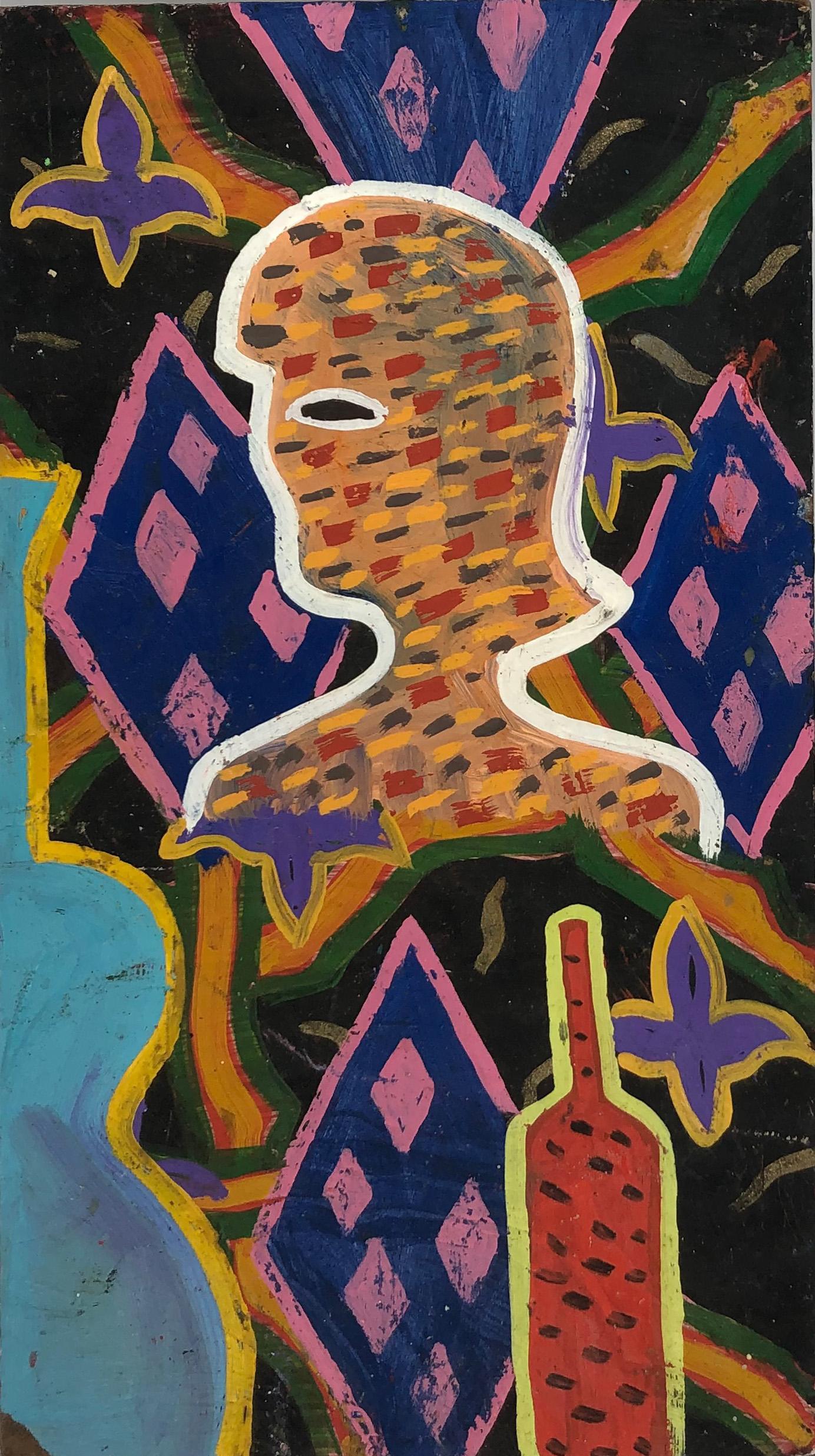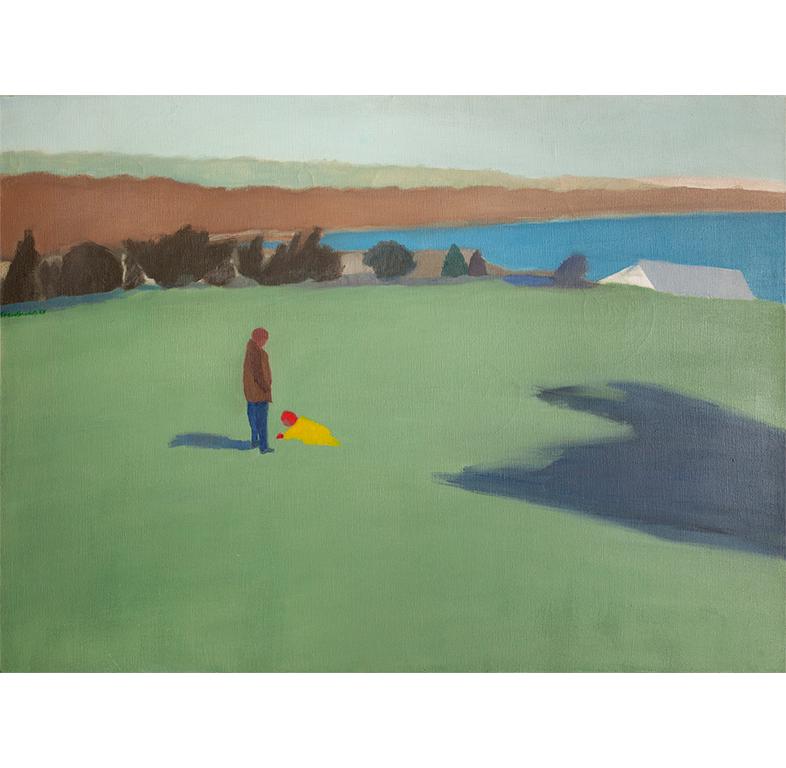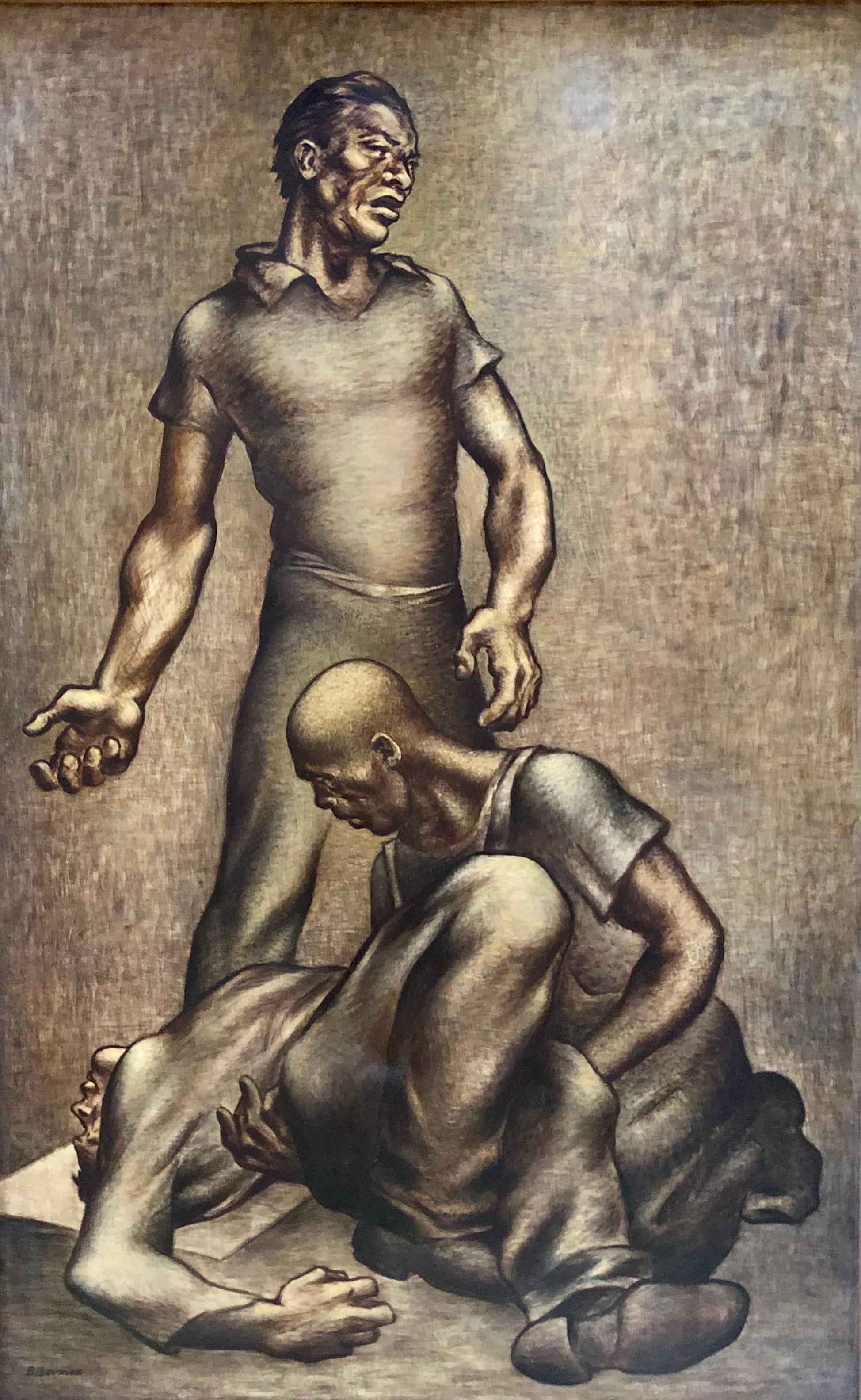Items Similar to Woman with Arms Crossed
Want more images or videos?
Request additional images or videos from the seller
1 of 7
Byron BrowneWoman with Arms Crossed1955
1955
About the Item
Woman with Arms Crossed
Mixed media collage-painting on stone chip surface, mounted on fabric, mounted on wood support by the artist, 1955
Signed and dated lower center
Image size: 11 7/8 x 7 inches
Wooden support size: 14 x 9 inches
Modernist painter and one of the founders of American Abstract Artists, a New York City organization devoted to exhibiting abstract art. Browne specialized in still life in the style of Synthetic Cubism, influenced by his friends John Graham, Arshile Gorky, and Willem de Kooning.
Joan Stahl American Artists in Photographic Portraits from the Peter A. Juley & Son Collection (Washington, D.C. and Mineola, New York: National Museum of American Art and Dover Publications, Inc., 1995)
Byron Browne was a central figure in many of the artistic and political groups that flourished during the 1930s. He was an early member of the Artists’ Union, a founding member of the American Abstract Artists, and participated in the Artists’ Congress until 1940 when political infighting prompted Browne and others to form the break-away Federation of Modern Painters and Sculptors. Browne’s artistic training followed traditional lines. From 1925 to 1928, he studied at the National Academy of Design, where in his last year he won the prestigious Third Hallgarten Prize for a still-life composition. Yet before finishing his studies, Browne discovered the newly established Gallery of Living Art. There and through his friends John Graham and Arshile Gorky, he became fascinated with Picasso, Braque, Miró, and other modern masters.
The mid 1930s were difficult financially for Browne.(1) His work was exhibited in a number of shows, but sales were few. Relief came when Burgoyne Diller began championing abstraction within the WPA’s mural division. Browne completed abstract works for Studio D at radio station WNYC, the U.S. Passport Office in Rockefeller Center, the Chronic Disease Hospital, the Williamsburg Housing Project, and the 1939 World’s Fair.(2)
Although Browne destroyed his early academic work shortly after leaving the National Academy, he remained steadfast in his commitment to the value of tradition, and especially to the work of Ingres.(3) Browne believed, with his friend Gorky, that every artist has to have tradition. Without tradition art is no good. Having a tradition enables you to tackle new problems with authority, with solid footing.(4)”
Browne’s stylistic excursions took many paths during the 1930s. His WNYC mural reflects the hard-edged Neo-plastic ideas of Diller, although a rougher Expressionism better suited his fascination for the primitive, mythical, and organic. A signer, with Harari and others, of the 1937 Art Front letter, which insisted that abstract art forms “are not separated from life,” Browne admitted nature to his art—whether as an abstracted still life, a fully nonobjective canvas built from colors seen in nature, or in portraits and figure drawings executed with immaculate, Ingres-like finesse.(5) He advocated nature as the foundation for all art and had little use for the spiritual and mystical arguments promoted by Hilla Rebay at the Guggenheim Collection: When I hear the words non-objective, intra-subjective, avant-garde and such trivialities, I run. There is only visible nature, visible to the eye or, visible by mechanical means, the telescope, microscope, etc.”(6)
Increasingly in the 1940s, Browne adopted an energetic, gestural style. Painterly brushstrokes and roughly textured surfaces amplify the primordial undercurrents posed by his symbolic and mythical themes. In 1945, Browne showed with Adolph Gottlieb, William Baziotes, David Hare, Hans Hofmann, Carl Holty, Romare Bearden, and Robert Motherwell at the newly opened Samuel Kootz Gallery. When Kootz suspended business for a year in 1948, Browne began showing at Grand Central Galleries. In 1950, he joined the faculty of the Art Students League, and in 1959 he began teaching advanced painting at New York University.
Courtesy of the Smithsonian Museum of American Art
- Creator:Byron Browne (1907-1961, American)
- Creation Year:1955
- Dimensions:Height: 11.875 in (30.17 cm)Width: 9 in (22.86 cm)
- Movement & Style:
- Period:
- Condition:
- Gallery Location:Fairlawn, OH
- Reference Number:
About the Seller
5.0
Recognized Seller
These prestigious sellers are industry leaders and represent the highest echelon for item quality and design.
Platinum Seller
These expertly vetted sellers are 1stDibs' most experienced sellers and are rated highest by our customers.
Established in 1978
1stDibs seller since 2013
711 sales on 1stDibs
Typical response time: 1 hour
Associations
International Fine Print Dealers Association
- ShippingRetrieving quote...Ships From: Fairlawn, OH
- Return PolicyA return for this item may be initiated within 10 days of delivery.
More From This SellerView All
- Basketball PlayerBy Ben ShahnLocated in Fairlawn, OHBasketball Player Gouache on card stock, c. 1940 Signed by the artist in ink lower center A study for the fresco mural in the Social Security Buildin...Category
1940s American Modern Figurative Paintings
MaterialsGouache
- Portrait of Young Woman (Self Portrait of the Artist?)Located in Fairlawn, OHPortrait of Young Woman (Self Portrait of the Artist?) Oil on canvas, pre 1963 Signed lower left edge (see photo) also see photo of signature from another work by the artist Newman Galleries label verso (a leading art gallery in Philadelphia, founded 1860 Condition: Excellent Canvas size: 30 1/16 x 18 1/8 inches Frame size: 32 x 20 inches Exhibited: Newman Gallery, Philadelphia Note: Tatiana was a talented portrait painter and baroness from a wealthy and aristocratic Italian family, who married the American artist Cy Towmbly in 1959. Tatiana married Cy Twombly in April of 1959. They had a son, Cyrus Alessandro, made famous in his painting The Age of Alexander, 1959-1960. Tatiana's brother, Baron Giorgio Francehtti, purchased the famous Venetian landmark, Ca' D' Oro, located on the Grand Canal. He formed a major collection of art. The Baron was a backer of the noted Roma art...Category
1960s Modern Figurative Paintings
MaterialsOil
- Neoclassical Head in profileBy Byron BrowneLocated in Fairlawn, OHNeoclassical Head in profile Watercolor and graphite on paper, 1950 Signed and dated lower left in ink (see photo) Provenance: Washington, D.C. priva...Category
1950s Modern Figurative Paintings
MaterialsWatercolor
- Woman in a FieldBy Henry BaconLocated in Fairlawn, OHWoman in a Field Oil on canvas, 1894 Signed and dated 1894, lower right corner Unframed A major exhibition work by this American Expatriate painter. From the linear descendants of th...Category
1890s Barbizon School Figurative Paintings
MaterialsOil
- Study for the Mural "Westward Movement"By John Steuart CurryLocated in Fairlawn, OHStudy for the Mural "Westward Movement" Graphite, watercolor, gouache and paint on paper, 1936 Signed in pencil lower center (see photo) A study leading up to his mural Justice of th...Category
1930s American Realist Figurative Paintings
MaterialsGouache
- untitledBy Darius StewardLocated in Fairlawn, OHSigned with the artist's initials lower right Watercolor on Twinrocker heavy weight paperCategory
2010s Contemporary Figurative Paintings
MaterialsWatercolor
You May Also Like
- Acadian Girl with DiamondsBy FPA Francis Pavy ArtistLocated in Lafayette, LAthe medium for this small painting is oil on Masonite. The painting shows a silhouette of a woman surrounded by diamonds fleur-de-lis's, a guitar and a bottle. on the reverse it reads: ACADIAN GIRL WITH DIAMONDS, © FRANCIS X PAVY...Category
Early 2000s American Modern Figurative Paintings
MaterialsOil
- 2 Girl StudyBy FPA Francis Pavy ArtistLocated in Lafayette, LAThis small word depicts two women with different hairstyles. The heads of the women are painted black with a yellow outline and blue spots in the interior. The background has red triangles with white centers and a block in the middle. The background is gold with green stripes around the triangles. On the reverse it reads:© Francis Pavy 2002, all rights reserved, #16102, 2 girl...Category
Early 2000s American Modern Figurative Paintings
MaterialsOil
- Southdown Field at Long Island Sound Beach Parent and childBy Stan BrodskyLocated in Brookville, NYThis large green field overlooking the Long Island Sound Beach depicts a parent without definition, mother or father, observing their child in the gr...Category
1960s American Modern Figurative Paintings
MaterialsOil
- Six O'ClockLocated in Los Angeles, CASix O-Clock, c. 1942, oil on canvas, 30 x 20 inches, signed and titled several times verso of frame and stretcher (perhaps by another hand), marked “Rehn” several times on frame (for the Frank K. M. Rehn Galleries in New York City, who represented Craig at the time); Exhibited: 1) 18th Biennial Exhibition of Contemporary American Oil Paintings from March 21 to May 2, 1943 at The Corcoran Gallery of Art in Washington, D.C. #87, original price $450 (per catalog) (exhibition label verso), 2) Craig’s one-man show at the Frank K. M. Rehn Galleries, New York City, from October 26 to November 14, 1942, #10 (original price listed as $350); and 3) Exhibition of thirty paintings sponsored by the Harrisburg Art Association at the State Museum of Pennsylvania in Harrisburg in March, 1944 (concerning this exhibit, Penelope Redd of The Evening News (Harrisburg, Pennsylvania) wrote: “Other paintings that have overtones of superrealism inherent in the subjects include Tom Craig’s California nocturne, ‘Six O’Clock,’ two figures moving through the twilight . . . .” March 6, 1944, p. 13); another label verso from The Museum of Art of Toledo (Ohio): original frame: Provenance includes George Stern Gallery, Los Angeles, CA About the Painting Long before Chris Burden’s iconic installation outside of the Los Angeles County Museum of Art, Urban Light, another artist, Tom Craig, made Southern California streetlights the subject of one of his early 1940s paintings. Consisting of dozens of recycled streetlights from the 1920s and 1930s forming a classical colonnade at the museum’s entrance, Burden’s Urban Light has become a symbol of Los Angeles. For Burden, the streetlights represent what constitutes an advanced society, something “safe after dark and beautiful to behold.” It seems that Craig is playing on the same theme in Six O-Clock. Although we see two hunched figures trudging along the sidewalk at the end of a long day, the real stars of this painting are the streetlights which brighten the twilight and silhouette another iconic symbol of Los Angeles, the palm trees in the distance. Mountains in the background and the distant view of a suburban neighborhood join the streetlights and palm trees as classic subject matter for a California Scene painting, but Craig gives us a twist by depicting the scene not as a sun-drenched natural expanse. Rather, Craig uses thin layers of oil paint, mimicking the watercolor technique for which he is most famous, to show us the twinkling beauty of manmade light and the safety it affords. Although Southern California is a land of natural wonders, the interventions of humanity are already everywhere in Los Angeles and as one critic noted, the resulting painting has an air of “superrealism.” About the Artist Thomas Theodore Craig was a well-known fixture in the Southern California art scene. He was born in Upland California. Craig graduated with a degree in botany from Pomona College and studied painting at Pamona and the Chouinard Art School with Stanton MacDonald-Wright and Barse Miller among others. He became close friends with fellow artist Milford Zornes...Category
1940s American Modern Landscape Paintings
MaterialsCanvas, Oil
- Fallen Comrades/InterludeLocated in Los Angeles, CAThis work is part of our exhibition - America Coast to Coast: Artists of the 1940s Fallen Comrades/Interlude, 1949, oil on masonite, signed lower left, 35 x 56 inches; Gallery Z la...Category
1940s American Modern Paintings
MaterialsMasonite, Oil
- Nude with DrapeBy Fletcher MartinLocated in Los Angeles, CANude with Drape, c. 1937, oil on board, 24 x 17 (oval), signed lower right, provenance: Frances Lee Kent Falcone Family Trust About the Painting Fletcher Martin’s Nude with Drape ...Category
1930s American Modern Figurative Paintings
MaterialsOil





